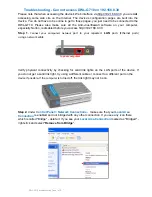
3-3
Cisco 10000 Series Router Software Configuration Guide
OL-2226-23
Chapter 3 Configuring Remote Access to MPLS VPN
Access Technologies
Access Technologies
The Cisco 10000 series router supports routed bridge encapsulation (RBE) protocol. Point-to-point
protocol (PPP) access-based permanent virtual circuits (PVCs) is supported by using the following
PPP access encapsulation methods:
•
PPP over ATM (PPPoA)
•
PPP over Ethernet (PPPoE)
By using these PPP access technologies, the Cisco 10000 series router can terminate up to 32,000
sessions and support many features, including:
•
Per session authentication based on Password Authentication Protocol (PAP) or Challenge
Handshake Authentication Protocol (CHAP)
•
Per session accounting
•
Per session quality of service
Note
The Cisco 10000 series router can terminate up to 32,000 ATM RBE sessions.
Figure 3-2
shows the topology of an integrated PPPoX (PPPoE or PPPoA) access to a multiprotocol label
switching virtual private network (MPLS VPN) solution.
Figure 3-2
PPPoX Access to MPLS VPN Topology
In the figure, the service provider operates an MPLS VPN that interconnects all customer sites. The
service provider’s core network is an MPLS backbone with VPN service capability. The service provider
provides all remote access operations to its customer. The network side interfaces are tagged interfaces,
logically separated into multiple VPNs.
CPE
Cisco 10000 ESR
Wholesale
provider
PPPoE
sessions
Tag interface,
logically separated
into multiple VPNs
Retail
provider
Provider 1
Provider 2
Provider n
ATM
access
network
VRF 1
VRF n
VRF 2
MPLS
network
69865
















































